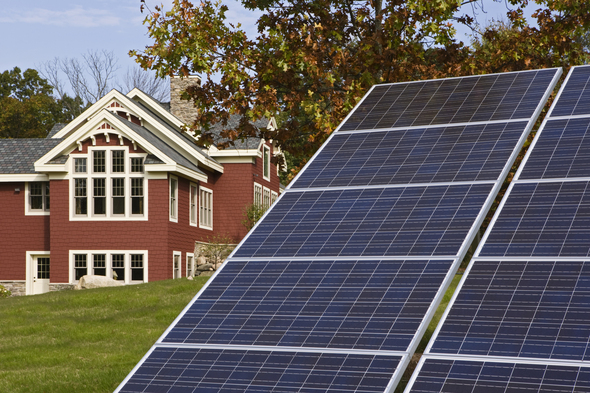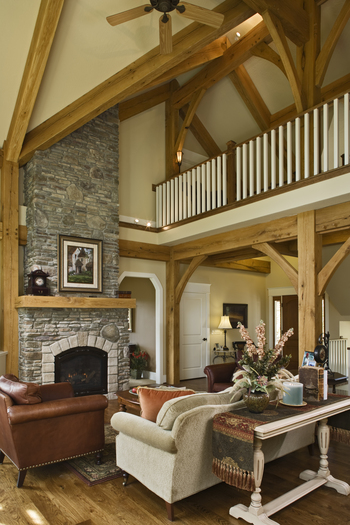Green Buildings for Cool Cities Tour comes to Ann Arbor this weekend

A bank of solar panels helps keep the heating and cooling costs low for this 4,000-square-foot home built by Fireside Home Construction in Webster Township.
Photo courtesy of Fireside Home Construction
Despite its rambling size, it only costs about $1,200 a year to heat and cool and that cost is expected to be halved with the addition of more solar panels, according to builder Bob Burnside, president and CEO of Fireside Home Construction.
But the house’s claim to environmental greenest doesn’t end there.
It was built so efficiently, Burnside said, that there was no Dumpster to haul away debris. None.
“We didn’t haul away one stick. It was all either used or recycled,” Burnside said.

A loft overlooks the great room inside the green, energy-efficient home built by Fireside Home Construction in Webster Township.
The home is used to showcase green building, Burnside said, with a goal of near-zero energy usage. It uses about 70 percent less energy than a typical house its size and generates 70 percent of its own energy.
In 2007, it was identified as one of the 12 greenest houses in America, and the first LEED platinum house in the state.
The house at 7150 Donovan Road is among eight local homes featured on the two-day Green Buildings for Cool Cities Tour this weekend.
Other stops on the tour include a house with an artful mish-mash of found windows and one that is designed to look historic but function with cutting edge green technology.
Ann Arbor has more LEED (Leadership in Energy and Environmental Design) platinum level homes per capita than any other metropolitan area in the United States, said Michael Klement, Ann Arbor architect and tour planner. LEED is the national standard for measuring green building.
“We want people to be aware that this can turn the rust belt into the green belt and that it started here in Ann Arbor. There is amazing (green building) density here,” Klement said.

The tour offers variety in building styles, Klement said, from new to remodeled, from simple ranches to houses with artistic flair.
“There are contemporary and Craftsman styles, traditional and wild,” he said. “We want to show that we can do any kind of house. People think green has a certain look, that you can tell it a mile away. You can’t.”

Using geothermal heating and cooling systems to dual flush toilets, all of these houses have been awarded the LEED platinum certification or pending certification, the top level for green building.
But what is most important about green building, Klement said, is that there is an integrated system. The design and the construction must be looked at holistically rather than bolting green features on at the end, he said. That means looking at where the house is sited, using natural daylight, respecting flora and fauna when selecting a site, using space efficiently to avoid building too big and more, he said.
The national tour is sponsored by the Sierra Club and the United States Green Building Council, which created the LEED rating system. Locally, the tour is also sponsored by the Ann Arbor Ecology Center and is being held in conjunction with the Mayor’s Green Fair on Friday evening on South Main Street downtown.
Most of the houses on the tour have a number of green elements in common, from geothermal heating and cooling to solar panels that create energy. Many have compact fluorescent light bulbs and high efficiency appliances. Some have native plant selection for landscaping to minimize water usage.
There are other less flashy elements to green building: Tight building envelopes, sealed tight to keep the cold out in winter and the heat out during summer; spray foam attic insulation, gravel driveways to minimize runoff and site selection to take advantage of solar orientation. Also, buying materials within a 500-mile radius.
THE HOUSES

• 620 N. Fourth Ave., Ann Arbor: The first LEED platinum whole-house remodel in the Great Lakes region and fifth in the nation. A compact house with a “Not So Big” design and geothermal heating and cooling.
• 723 Spring, Ann Arbor: The city’s first LEED platinum house, with geothermal heating and cooling and low-flow fixtures.
• 514 Fountain, Ann Arbor: Styled after a 1920s era Craftsman house, this home was built on an empty lot in a historic neighborhood. It has insulated concrete forms and geothermal heating and cooling.
• 1303 Brooks, Ann Arbor: Another “Not So Big” design, this was a whole house remodel that included solar heating and geothermal heating and cooling.
• 7150 Donovan, Webster Township: This 4,000-square-foot timber frame house became the model for green building.
• 9020 Island Lake Road, Dexter: A new, ranch-style house with geothermal heating and cooling, dual flush toilets and green-label carpeting to avoid toxic outgassing.
• 341 Evergreen Place, Ann Arbor: The state’s second whole-house LEED platinum remodel, this 1950s house went from typical mid-century modern to artist’s palette, and includes a 600-gallon rain collection system, an outdoor shower and more than a dozen “found” windows.
• 4675 Arkona Road, Saline: Replaces a five-generation farmhouse that burned, the goal of this house was to build it so it would have a net energy use of zero. A tight building envelope and solar panels on the awnings move toward this goal.


Comments
Scott Phillips
Thu, Jun 10, 2010 : 5:47 p.m.
Here is a link to a YouTube to an educational video about 723 Spring Street http://www.youtube.com/watch?v=ZfQliOpXQwc
Atticus F.
Thu, Jun 10, 2010 : 3:49 p.m.
I'm always happy to see people with extra money investing it in alternate energy!
AAJoker
Thu, Jun 10, 2010 : 12:03 p.m.
I didn't realize that creating an on-site dump by burying the waste was considered "recycling"... oh I'm sorry, they were "worked into the soil". Wouldn't it be more green to not be building new housing at all?